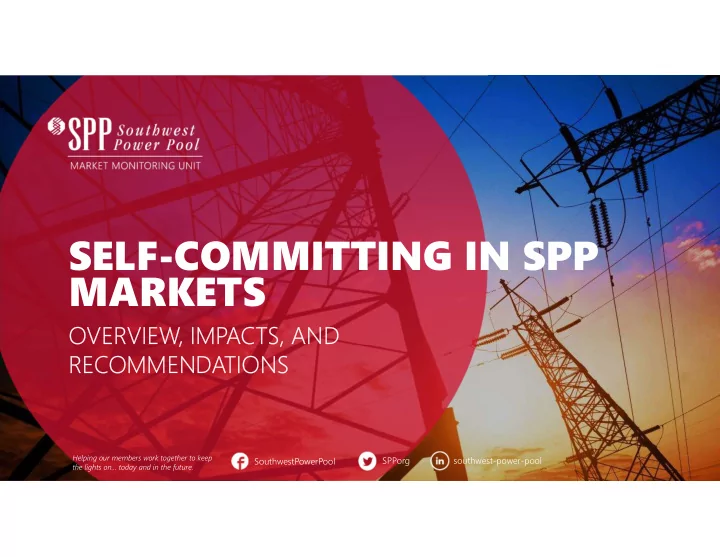

SELF-COMMITTING IN SPP MARKETS OVERVIEW, IMPACTS, AND RECOMMENDATIONS Helping our members work together to keep SPPorg southwest-power-pool SouthwestPowerPool the lights on... today and in the future.
OUTLINE Opening remarks Recommendations Takeaways Conceptual models and empirical research Simulations Q&A MMU 2
RECOMMENDATIONS • In order to improve price formation and market efficiency, we recommend SPP and stakeholders work to reduce the incidence of self-commitments. • We recommend modifying SPP’s market design by adding one additional day to the market optimization period. MMU 3
TAKEAWAYS: EMPIRICAL RESEARCH • The volume of self-committed megawatts has declined over time, but remains nearly half of the recent megawatt volume. • Resources with long lead times and/or high start-up costs tend to be self-committed instead of market-committed. • Units that are self-committed generally have much higher capacity factors than those that are market-committed. However, these results differ substantially by fuel type. • In almost all cases, self-committed generators had lower revenues because of negative congestion prices; whereas, market-committed generators typically had a more balanced congestion profile. MMU 4
TAKEAWAYS: SIMULATIONS • When the market made unit commitment decisions, and lead times remained unchanged, both market-wide production costs and market clearing prices for energy increased. • When the market made unit commitment decisions and lead times were modified to allow the day-ahead market to commit the resources with longer lead times, market- wide production costs were essentially unchanged and market clearing prices for energy increased. • System-wide energy prices increased by about $2/MWh (seven percent) on average. • Congestion prices changed by about –$1/MWh to $1/MWh on average. • To optimize long-lead time resources’ participation in the market, the economic commitment process would need to solve over a longer market window. MMU 5
RIGHTWARD SHIFT IN MARKET SUPPLY CURVE MMU 6
THE MARKET FEEDBACK LOOP Market Prices Installed Investment & capacity retirement MMU 7
PERCENTAGE OF MEGAWATTS DISPATCHED BY COMMITMENT STATUS MMU 8
PERCENTAGE OF SELF-COMMITTED MEGAWATTS BY FUEL TYPE MMU 9
DISPATCH MEGAWATT HOURS BY FUEL TYPE BY COMMITMENT TYPE MMU 10
LEAD TIME HOURS BY COMMITMENT STATUS MMU 11
COLD START TIME AND COLD START COST BY RESOURCE FUEL TYPE MMU 12
CAPACITY FACTORS BY FUEL TYPE BY COMMITMENT TYPE MMU 13
PERCENTAGE OF MARGINAL HOURS BY FUEL TYPE, INTRA-HOUR CLASSIFICATION MMU 14
GENERATION MEGAWATTS TO LOAD MEGAWATTS BY COMMITMENT TYPE MMU 15
CONGESTION DOLLARS BY FUEL TYPE, BY COMMITMENT STATUS MMU 16
FINDINGS: SIMULATIONS • The key to reducing self-commitment while not increasing costs is multi-day economic unit commitment. • Increasing the optimization window by another 24 hours allows the market to more effectively optimize resources with long start-up times. This enhancement combined with a reduction in self-commitment, would likely benefit ratepayers by reducing production costs in addition to sending more clear investment signals. • If the optimization window is not lengthened, and self-commitment is eliminated, investment signals would be more clear, but production costs would likely increase. MMU 17
SCENARIO 1 VS SCENARIO 2, SYSTEM MARGINAL PRICE AND PRODUCTION COST MMU 18
SCENARIO 1 VS SCENARIO 3, SYSTEM MARGINAL PRICE AND PRODUCTION COST MMU 19
SCENARIO 1 VS SCENARIO 3, DISPATCH MEGAWATTS BY FUEL TYPE MMU 20
SCENARIO 1 AND SCENARIO 3 COMPARISON, DIFFERENCE IN CONGESTION COSTS MMU 21
Recommend
More recommend